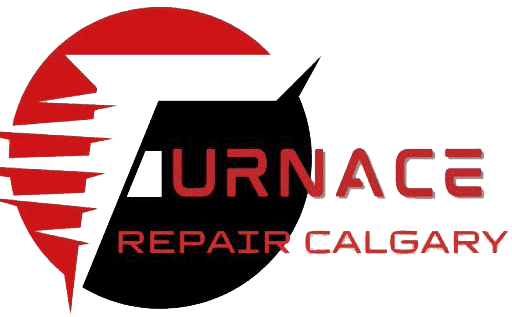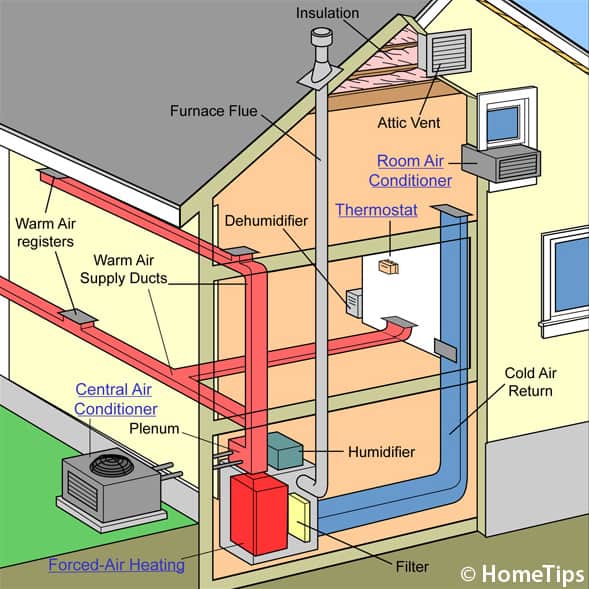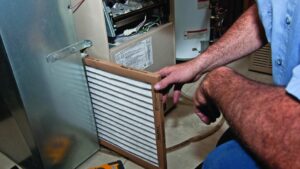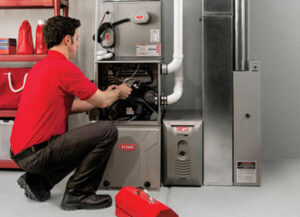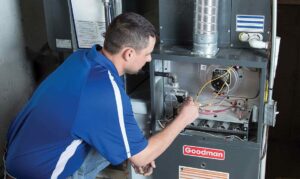Forced Air Heating Guide
What is forced air heating? Suppose you are looking for a new heating system for your home. In that case, you may have wondered how they work and what are the advantages and disadvantages of forced air heating in Calgary, Alberta? Let’s dig into this crucial residential furnace.
How Does a Forced Air Furnace Work?
It’s essential to know how a forced air furnace works.
Forced air furnaces heat the air and then distribute it through the house via ductwork and in-room vents. Homeowners set the desired temperature using the thermostat. The blower pulls the cool air from your home into the furnace through the cold air return. The cool air passes through the air filter, removing allergens. The cool air circulates the heat exchanger until it’s warmed. Finally, the warm air spreads throughout the home through ducts.
The heating process repeats itself until the home temperature matches the thermostat temperature.
Is Forced Air Heating Expensive
For most Alberta homes, forced air is the most cost-effective heating system. For a high-efficiency furnace, expect to pay $3,000 to $6,000 (including installation).
What’s the Difference Between Central Air and Forced Air
Primarily, forced air applies to heating systems, while central air refers to air-conditioning systems. However, sometimes people use the two terms interchangeably.
Is Forced Air System Gas or Electric?
Gas furnaces are the most common heating system in Alberta because of their ability to heat homes much faster than electric furnaces. However, gas-fueled furnaces are not as efficient as electric. The maximum AFUE for gas furnaces is 98.5%. In contrast, electric furnaces can achieve 100% AFUE.
In addition to gas and electricity, forced air systems use natural gas, propane, and oil.
Advantages of Using Forced Air Heating Model System
Below we have provided you with some of the benefits of having a sound forced air heating model system.
Affordable
It is more affordable to purchase a forced-air system than a radiant heating system such as a boiler. Moreover, the installation is also more affordable. While the installation of ductwork can be complicated, it is more straightforward than installing in-floor heating.
Share Ductwork with Air Conditioner
If ductwork exists for a forced-air furnace, a central air conditioning unit can share that ductwork.
Energy costs
Forced air heating systems are typically energy-efficient. Homeowners who rely on natural gas, such as Albertans, mainly use forced air systems. The operating costs are very cheap compared to the electrical furnace systems.
Quick heating
Heating air directly and then distributing that warm air throughout the house is a quick process. In contrast, it takes longer for a home to reach the desired temperature with radiant heating.
Reliability
Heat and electric pumps tend to be less reliable as opposed to the forced air heating model systems. The ductwork usually consists of very few parts of which can spoil and break down. The components tend to be very simple. These parts can include motors, belts, or fans, which are easily replaceable in case of any problems.
Disadvantages of Forced Air Heating
Noise
Generally, the forced air systems are noisy. Even though the forced air systems over the years have advanced, pushing air using pressure through ducts will produce noises as the system kicks on.
Air ducts
Most of the forced air systems, if not correctly maintained, can accumulate mold and dust, especially at the air ducts. When the forced air system ducts have accumulated dust, it can spread in your place and cause respiratory issues.
Having difficulty turning on your furnace?
How to Properly Maintain Your Forced-Air System
For forced-air systems, proper furnace maintenance includes checking the air filters. In case the air filter present is clogged, this will, in turn, force your heating system to work much harder to distribute heat throughout your place.
You should be able to clean or replace the filters every month, especially in the winter and after three months or rather two, during the remaining part of the year.
It would help if you also considered performing a regular tune-up for your heating system to avoid common problems. A tune-up includes:
A thorough furnace tune-up includes the following services:
- Inspect heat exchanger
- Inspect and clean burner
- Lubricate all moving parts
- Tighten all electrical connections
- Check voltage
- Test exhaust system
- Adjust fan belts
- Adjust gas pressure
Choosing the Right Heating System
Hopefully, this article has answered the question: what is forced air heating?
If you are not sure which heating model is suitable for your place, you can schedule a call with your HVAC expert to assist you in making up your mind. The heating system model should be able to keep you and your family warm, safe, and comfortable.
